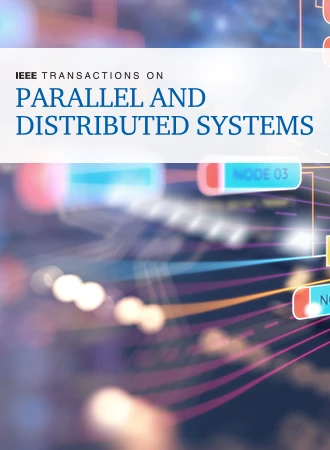$ \mathsf{GPABE} $GPABE: GPU-Based Parallelization Framework for Attribute-Based Encryption Schemes
IF 5.6
2区 计算机科学
Q1 COMPUTER SCIENCE, THEORY & METHODS
IEEE Transactions on Parallel and Distributed Systems
Pub Date : 2025-01-13
DOI:10.1109/TPDS.2025.3529776
引用次数: 0
Abstract
Attribute-based encryption (ABE) has emerged as a new paradigm for access control in cloud computing. However, despite the many promising features of ABE, its deployment in real-world systems is still limited, partially due to the expensive cost of its underlying mathematical operations, which often grow linearly with the size and complexity of the system's security policies. This becomes particularly challenging in data-intensive applications, where multiple users may simultaneously access and manipulate large volumes of data, resulting in high levels of concurrency and demand for computing resources, which are too heavy even for high-end servers. Further exacerbating the issues are the functionality and security requirements of a cloud, as they introduce additional computations to both the client and the server. Therefore, in this work, we introduce$ \mathsf{gabe} $ gabe:基于gpu的基于属性的加密方案并行化框架
基于属性的加密(ABE)已经成为云计算中访问控制的一种新范式。然而,尽管ABE有许多有前途的特性,但其在实际系统中的部署仍然有限,部分原因是其底层数学操作的昂贵成本,其成本通常与系统安全策略的大小和复杂性呈线性增长。这在数据密集型应用程序中尤其具有挑战性,在这些应用程序中,多个用户可能同时访问和操作大量数据,从而导致高并发性和对计算资源的需求,即使对于高端服务器来说,这些资源也过于繁重。使问题进一步恶化的是云的功能和安全需求,因为它们向客户机和服务器引入了额外的计算。因此,在这项工作中,我们引入了第一个基于gpu的ABE并行化框架$ \mathsf{gabe} $,以促进其在云计算中的批处理。通过分析ABE的主要计算工作量,我们确定了在基于配对的ABE设计中常见的多个算法模块。在此基础上,我们进一步提出将ABE算法分解为计算图,并在GPU平台上高效实现。我们的图形表示在ABE的高级设计和它们在gpu上的低级实现之间架起了桥梁,并且适用于ABE领域的各种流行方案。然后,我们将$ \mathsf{gabe} $实现为异构计算服务器,并使用几种优化技术来提高其吞吐量。最后,我们使用$ \mathsf{gabe} $来评估几种ABE方案的GPU实现。结果显示,与最先进的CPU实现相比,ABE算法的吞吐量至少提高了51.0倍,最多提高了253.6倍,这初步证明了$ \mathsf{gabe} $的有效性。
本文章由计算机程序翻译,如有差异,请以英文原文为准。
求助全文
约1分钟内获得全文
求助全文
来源期刊

IEEE Transactions on Parallel and Distributed Systems
工程技术-工程:电子与电气
CiteScore
11.00
自引率
9.40%
发文量
281
审稿时长
5.6 months
期刊介绍:
IEEE Transactions on Parallel and Distributed Systems (TPDS) is published monthly. It publishes a range of papers, comments on previously published papers, and survey articles that deal with the parallel and distributed systems research areas of current importance to our readers. Particular areas of interest include, but are not limited to:
a) Parallel and distributed algorithms, focusing on topics such as: models of computation; numerical, combinatorial, and data-intensive parallel algorithms, scalability of algorithms and data structures for parallel and distributed systems, communication and synchronization protocols, network algorithms, scheduling, and load balancing.
b) Applications of parallel and distributed computing, including computational and data-enabled science and engineering, big data applications, parallel crowd sourcing, large-scale social network analysis, management of big data, cloud and grid computing, scientific and biomedical applications, mobile computing, and cyber-physical systems.
c) Parallel and distributed architectures, including architectures for instruction-level and thread-level parallelism; design, analysis, implementation, fault resilience and performance measurements of multiple-processor systems; multicore processors, heterogeneous many-core systems; petascale and exascale systems designs; novel big data architectures; special purpose architectures, including graphics processors, signal processors, network processors, media accelerators, and other special purpose processors and accelerators; impact of technology on architecture; network and interconnect architectures; parallel I/O and storage systems; architecture of the memory hierarchy; power-efficient and green computing architectures; dependable architectures; and performance modeling and evaluation.
d) Parallel and distributed software, including parallel and multicore programming languages and compilers, runtime systems, operating systems, Internet computing and web services, resource management including green computing, middleware for grids, clouds, and data centers, libraries, performance modeling and evaluation, parallel programming paradigms, and programming environments and tools.
 求助内容:
求助内容: 应助结果提醒方式:
应助结果提醒方式:


